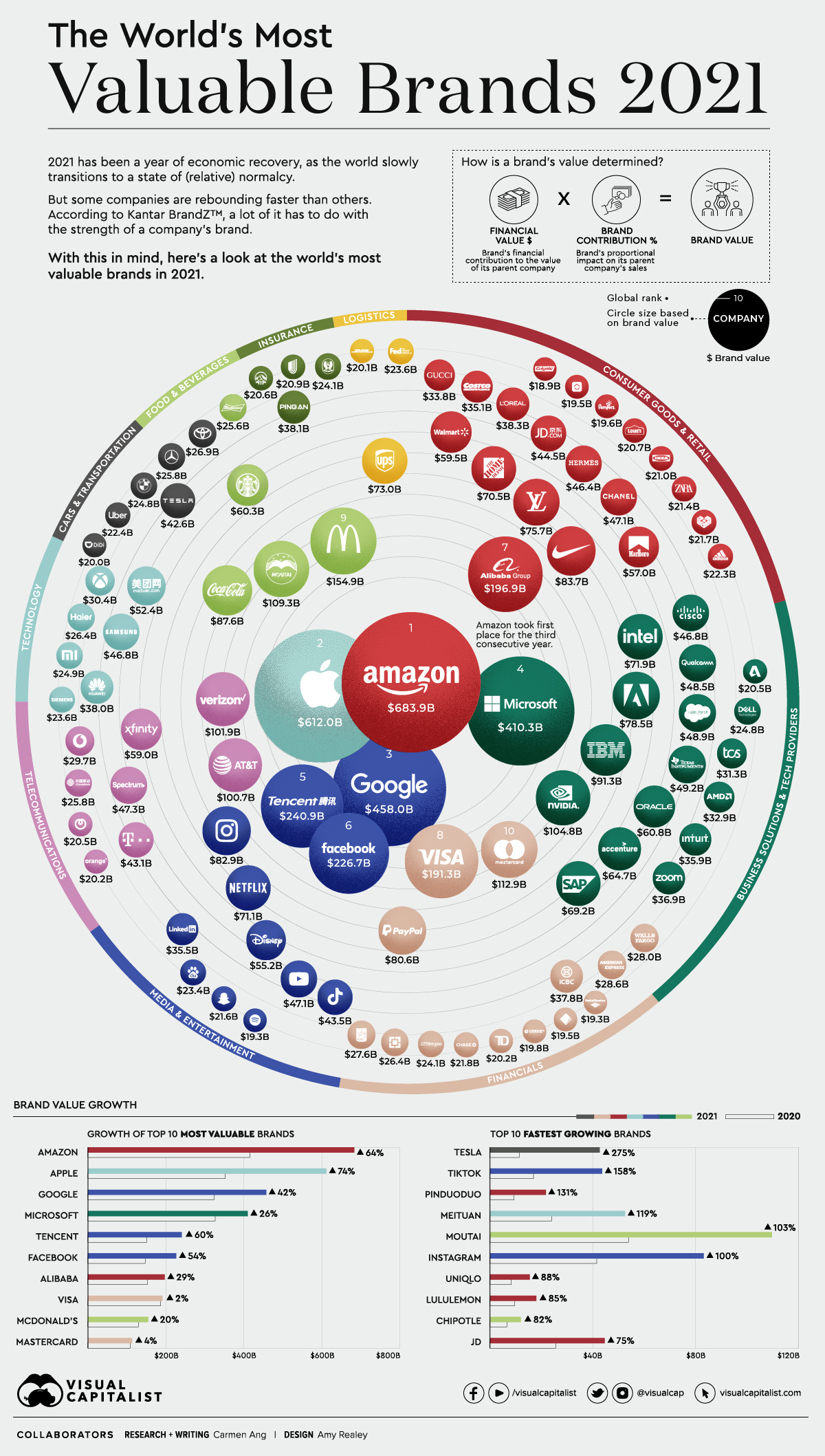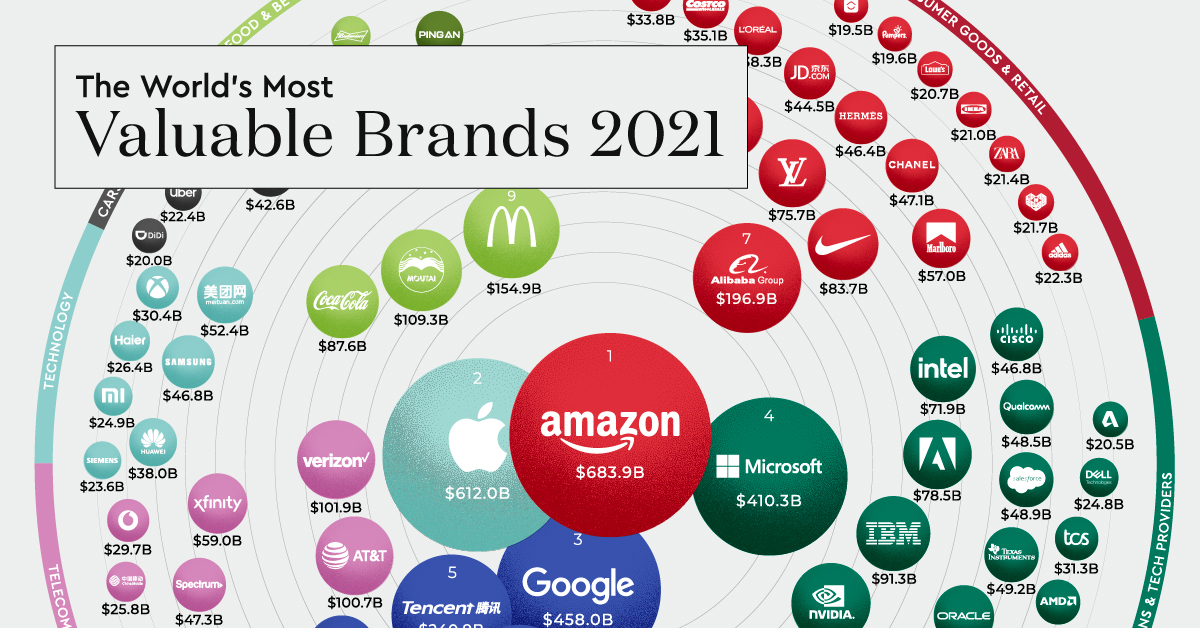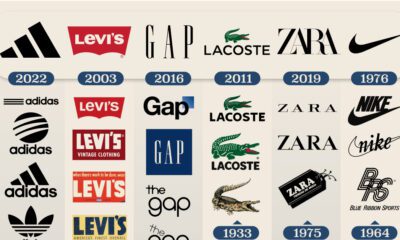Markets
The World’s 100 Most Valuable Brands in 2021
View the full-size version of this graphic.
The World’s Top 100 Most Valuable Brands in 2021
In 2020, the global economy experienced one of the worst declines since the Great Depression.
Yet, while the ripple effects of COVID-19 have thrown many businesses into disarray, some companies have not only managed to stay afloat amidst the chaos—they’ve thrived. Using data from Kantar BrandZ, this graphic looks at the top 100 most valuable brands of 2021.
Methodology
Each year, research group Kantar BrandZ ranks companies based on their “brand value,” which is measured by:
- A brand’s total financial value, which is the financial contribution that brand brings to its parent company ($ value).
- Multiplied by its proportional value, measured by the brands proportional impact on its parent company’s sales (% value).
The financial results are then combined with quantitative survey data, sourced from over 170,000 global consumers. The end result is a holistic look at a company’s brand equity, reputation, and ability to generate value.
The Leaderboard
The total value of 2021’s Top 100 brands grew by 42%, reaching a combined $7 trillion. At the top of the list, perhaps unsurprisingly, is Amazon, with a total brand value of $683 billion.
| Rank | Brand | Brand Value ($B USD) | Category | Brand Value % change from 2020 |
|---|---|---|---|---|
| 1 | Amazon | $683.85 | Consumer Goods & Retail | 64% |
| 2 | Apple | $612.00 | Technology | 74% |
| 3 | $458.00 | Media & Entertainment | 42% | |
| 4 | Microsoft | $410.27 | Business Solutions & Tech Providers | 26% |
| 5 | Tencent | $240.93 | Media & Entertainment | 60% |
| 6 | $226.74 | Media & Entertainment | 54% | |
| 7 | Alibaba | $196.91 | Consumer Goods & Retail | 29% |
| 8 | Visa | $191.29 | Financial Services | 2% |
| 9 | McDonald's | $154.92 | Food & Beverages | 20% |
| 10 | Mastercard | $112.88 | Financial Services | 4% |
| 11 | Moutai | $109.33 | Food & Beverages | 103% |
| 12 | Nvidia | $104.76 | Business Solutions & Tech Providers | n/a |
| 13 | Verizon | $101.94 | Telecom Providers | 8% |
| 14 | AT&T | $100.65 | Telecom Providers | -5% |
| 15 | IBM | $91.34 | Business Solutions & Tech Providers | 9% |
| 16 | Coca-Cola | $87.60 | Food & Beverages | 4% |
| 17 | Nike | $83.71 | Consumer Goods & Retail | 68% |
| 18 | $82.90 | Media & Entertainment | 100% | |
| 19 | PayPal | $80.62 | Payments | 66% |
| 20 | Adobe | $78.52 | Business Solutions & Tech Providers | n/a |
| 21 | Louis Vuitton | $75.73 | Consumer Goods & Retail | 46% |
| 22 | UPS | $73.02 | Logistics | 44% |
| 23 | Intel | $71.94 | Business Solutions & Tech Providers | n/a |
| 24 | Netflix | $71.13 | Media & Entertainment | 55% |
| 25 | The Home Depot | $70.52 | Consumer Goods & Retail | 22% |
| 26 | SAP | $69.24 | Business Solutions & Tech Providers | 20% |
| 27 | Accenture | $64.73 | Business Solutions & Tech Providers | n/a |
| 28 | Oracle | $60.84 | Business Solutions & Tech Providers | n/a |
| 29 | Starbucks | $60.27 | Food & Beverages | 26% |
| 30 | Walmart | $59.52 | Consumer Goods & Retail | 30% |
| 31 | Xfinity | $59.00 | Telecom Providers | 26% |
| 32 | Marlboro | $57.01 | Consumer Goods & Retail | -2% |
| 33 | Disney | $55.22 | Media & Entertainment | 13% |
| 34 | Meituan | $52.40 | Technology | 119% |
| 35 | Texas Instruments | $49.24 | Business Solutions & Tech Providers | n/a |
| 36 | Salesforce | $48.98 | Business Solutions & Tech Providers | 61% |
| 37 | Qualcomm | $48.36 | Business Solutions & Tech Providers | n/a |
| 38 | Spectrum | $47.28 | Telecom Providers | 10% |
| 39 | YouTube | $47.10 | Media & Entertainment | 39% |
| 40 | Chanel | $47.05 | Consumer Goods & Retail | 30% |
| 41 | Cisco | $46.82 | Business Solutions & Tech Providers | n/a |
| 42 | Samsung | $46.77 | Technology | 44% |
| 43 | Hermès | $46.40 | Consumer Goods & Retail | 40% |
| 44 | JD | $44.52 | Consumer Goods & Retail | 75% |
| 45 | TikTok | $43.52 | Media & Entertainment | 158% |
| 46 | Deutsche Telekom | $43.10 | Telecom Providers | 16% |
| 47 | Tesla | $42.61 | Cars & Transportation | 275% |
| 48 | L'Oréal Paris | $38.31 | Consumer Goods & Retail | 30% |
| 49 | Ping An | $38.05 | Insurance | 13% |
| 50 | Huawei | $38.02 | Technology | 29% |
| 51 | ICBC | $37.77 | Financial Services | -1% |
| 52 | Zoom | $36.93 | Business Solutions & Tech Providers | n/a |
| 53 | Intuit | $35.87 | Business Solutions & Tech Providers | n/a |
| 54 | $35.52 | Media & Entertainment | 19% | |
| 55 | Costco | $35.14 | Consumer Goods & Retail | 23% |
| 56 | Gucci | $33.84 | Consumer Goods & Retail | 24% |
| 57 | AMD | $32.92 | Business Solutions & Tech Providers | n/a |
| 58 | Tata Consulting Services | $31.28 | Business Solutions & Tech Providers | n/a |
| 59 | Xbox | $30.40 | Technology | 55% |
| 60 | Vodafone | $29.74 | Telecom Providers | 29% |
| 61 | American Express | $28.58 | Financial Services | -3% |
| 62 | Wells Fargo | $28.00 | Financial Services | -8% |
| 63 | RBC | $27.61 | Financial Services | 33% |
| 64 | Toyota | $26.97 | Cars & Transportation | -5% |
| 65 | Haier | $26.42 | Technology | 41% |
| 66 | HDFC Bank | $26.37 | Financial Services | 27% |
| 67 | Mercedes-Benz | $25.84 | Cars & Transportation | 21% |
| 68 | China Mobile | $25.82 | Telecom Providers | -25% |
| 69 | Budweiser | $25.55 | Food & Beverages | 5% |
| 70 | Xiaomi | $24.89 | Technology | 50% |
| 71 | BMW | $24.82 | Cars & Transportation | 21% |
| 72 | Dell Technologies | $24.78 | Business Solutions & Tech Providers | 36% |
| 73 | LIC | $24.14 | Insurance | 38% |
| 74 | J.P. Morgan | $24.11 | Financial Services | 37% |
| 75 | Siemens | $23.64 | Conglomerate | 69% |
| 76 | Fedex | $23.59 | Logistics | 53% |
| 77 | Baidu | $23.36 | Media & Entertainment | 57% |
| 78 | Uber | $22.41 | Cars & Transportation | 41% |
| 79 | Adidas | $22.34 | Consumer Goods & Retail | 51% |
| 80 | Chase | $21.83 | Financial Services | 7% |
| 81 | Pinduoduo | $21.73 | Consumer Goods & Retail | 131% |
| 82 | Snapchat | $21.61 | Media & Entertainment | n/a |
| 83 | Zara | $21.38 | Consumer Goods & Retail | 0% |
| 84 | Ikea | $21.02 | Consumer Goods & Retail | 17% |
| 85 | UnitedHealthCare | $20.87 | Insurance | 32% |
| 86 | Lowe's | $20.67 | Consumer Goods & Retail | 51% |
| 87 | AIA | $20.60 | Insurance | 16% |
| 88 | NTT | $20.48 | Telecom Providers | 1% |
| 89 | Autodesk | $20.45 | Business Solutions & Tech Providers | n/a |
| 90 | TD | $20.21 | Financial Services | 17% |
| 91 | Orange | $20.20 | Telecom Providers | 4% |
| 92 | DHL | $20.14 | Logistics | 39% |
| 93 | Didi Chuxing | $20.04 | Cars & Transportation | 0% |
| 94 | China Construction Bank | $19.78 | Financial Services | -6% |
| 95 | Pampers | $19.62 | Consumer Goods & Retail | 6% |
| 96 | KE | $19.50 | Consumer Goods & Retail | n/a |
| 97 | Commonwealth Bank | $19.47 | Financial Services | 48% |
| 98 | Bank of America | $19.32 | Financial Services | 14% |
| 99 | Spotify | $19.28 | Media & Entertainment | n/a |
| 100 | Colgate | $18.89 | Consumer Goods & Retail | 8% |
It’s the third consecutive year that Amazon has placed first on the list. Since last year’s ranking, the ecommerce brand has seen its value grow by 64%. Keep in mind, this accounts for all areas of Amazon’s business, including its web and subscription services.
Second on the list is Apple with a brand value of $612 billion. Apple wasn’t completely immune to the impacts of COVID-19—in the early days of the pandemic, its stock dipped almost 19% from record highs—but the company recovered and reported record-breaking revenue, generating $64.7 billion in Q4 2020.
It’s fitting that the top brands on the list are big tech companies since the pandemic pushed consumers online for both their shopping and entertainment needs. A few social media platforms placed high on the list as well, like Facebook, which rose two ranks this year to score the sixth spot with a brand value of $227 billion.
Instagram and TikTok trailed behind Facebook when it came to total brand value, but both platforms saw exceptional growth compared to last year’s report. In fact, when looking at brand value growth from 2020, both brands scored a spot in the top 10.
Insights into Brand Value Growth
The most valuable brand report has been ranking companies for over a decade, and some overarching factors have stood out as key contributors to brand value growth:
1. The Big Get Bigger
Starting “strong” can give brands an edge. This is because growth rate is closely correlated with high brand equity. In other words, a strong brand will likely see more growth than a weaker brand, which might explain why companies like Amazon and Apple have been able to hold their place at the top for several consecutive years.
Keep in mind, this doesn’t account for industry disruptors. An innovative company could come out of the woodwork next year and give the Big Tech giants a run for their money.
2. Marketing Makes a Difference
The right strategy can make a difference, and even smaller brands can make a splash if the message is impactful. Brands with emotional associations, like pride or popularity, tend to see that translate into brand value growth.
Companies like Nike and Coca-Cola have mastered the art of emotional advertising. For instance, in May last year, Nike released a video urging consumers to stand up for equality, in a video titled, “For Once, Just Don’t Do It.”
3. Smart Investment
It’s not just about developing an effective marketing strategy, it’s about executing that strategy, and continually investing in ways that perpetuate your brand message.
For instance, innovation is the core value of Tesla’s brand, and the electric car company walks the walk—in 2020, the company spent $1.5 billion on R&D.
Maps
Mapped: The 10 U.S. States With the Lowest Real GDP Growth
In this graphic, we show where real GDP lagged the most across America in 2023 as high interest rates weighed on state economies.

The Top 10 U.S. States, by Lowest Real GDP Growth
This was originally posted on our Voronoi app. Download the app for free on iOS or Android and discover incredible data-driven charts from a variety of trusted sources.
While the U.S. economy defied expectations in 2023, posting 2.5% in real GDP growth, several states lagged behind.
Last year, oil-producing states led the pack in terms of real GDP growth across America, while the lowest growth was seen in states that were more sensitive to the impact of high interest rates, particularly due to slowdowns in the manufacturing and finance sectors.
This graphic shows the 10 states with the least robust real GDP growth in 2023, based on data from the Bureau of Economic Analysis.
Weakest State Economies in 2023
Below, we show the states with the slowest economic activity in inflation-adjusted terms, using chained 2017 dollars:
| Rank | State | Real GDP Growth 2023 YoY | Real GDP 2023 |
|---|---|---|---|
| 1 | Delaware | -1.2% | $74B |
| 2 | Wisconsin | +0.2% | $337B |
| 3 | New York | +0.7% | $1.8T |
| 4 | Missississippi | +0.7% | $115B |
| 5 | Georgia | +0.8% | $661B |
| 6 | Minnesota | +1.2% | $384B |
| 7 | New Hampshire | +1.2% | $91B |
| 8 | Ohio | +1.2% | $698B |
| 9 | Iowa | +1.3% | $200B |
| 10 | Illinois | +1.3% | $876B |
| U.S. | +2.5% | $22.4T |
Delaware witnessed the slowest growth in the country, with real GDP growth of -1.2% over the year as a sluggish finance and insurance sector dampened the state’s economy.
Like Delaware, the Midwestern state of Wisconsin also experienced declines across the finance and insurance sector, in addition to steep drops in the agriculture and manufacturing industries.
America’s third-biggest economy, New York, grew just 0.7% in 2023, falling far below the U.S. average. High interest rates took a toll on key sectors, with notable slowdowns in the construction and manufacturing sectors. In addition, falling home prices and a weaker job market contributed to slower economic growth.
Meanwhile, Georgia experienced the fifth-lowest real GDP growth rate. In March 2024, Rivian paused plans to build a $5 billion EV factory in Georgia, which was set to be one of the biggest economic development initiatives in the state in history.
These delays are likely to exacerbate setbacks for the state, however, both Kia and Hyundai have made significant investments in the EV industry, which could help boost Georgia’s manufacturing sector looking ahead.
-

 Personal Finance1 week ago
Personal Finance1 week agoVisualizing the Tax Burden of Every U.S. State
-

 Misc6 days ago
Misc6 days agoVisualized: Aircraft Carriers by Country
-

 Culture7 days ago
Culture7 days agoHow Popular Snack Brand Logos Have Changed
-

 Mining1 week ago
Mining1 week agoVisualizing Copper Production by Country in 2023
-

 Misc1 week ago
Misc1 week agoCharted: How Americans Feel About Federal Government Agencies
-

 Healthcare1 week ago
Healthcare1 week agoWhich Countries Have the Highest Infant Mortality Rates?
-

 Demographics1 week ago
Demographics1 week agoMapped: U.S. Immigrants by Region
-

 Maps1 week ago
Maps1 week agoMapped: Southeast Asia’s GDP Per Capita, by Country



















